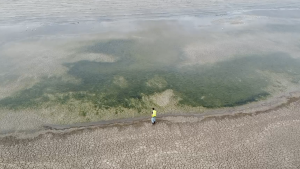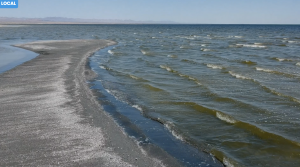Source: MynewsLA.com
Riverside County supervisors Tuesday approved a $4.12 million contract with an Encinitas-based firm to provide engineering and design services for a project to revitalize a portion of the dying Salton Sea.
“We’ve been working on this project for several years now,” Salton Sea Authority Executive Director Patrick O’Dowd told the Board of Supervisors. “It’s a big day for the community of North Shore and a big day for Riverside County.”
The two-year agreement with Dudek Consulting formally marks initiation of the Salton Sea North Lake Pilot Demonstration Project, conceived four years ago.

“With the Salton Sea, there have been lots of studies done over the last four or five decades,” said board Chairman Jeff Hewitt, who sits on the Salton Sea Authority Board. “There have been lots of things where hands went up in the air, so it’s great to see something happening where they’re going to be moving some dirt in a good way.”
Supervisor Manuel Perez, whose Fourth District encompasses the north end of the Salton Sea, pointed out that roughly $19 million in Proposition 68 funds have been allocated for the project. Prop 68 was approved in 2018 as the California Drought, Water, Parks, Climate, Coastal Protection & Outdoor Access for All Act.
“More money is coming,” Perez said. “We’re working with our legislators to do what’s best. This is going to bring economic development, jobs, trailways and parks. People want amenities.”
The North Lake project was first discussed in 2018 and was ultimately incorporated into the larger revitalization effort, which envisions maintaining and improving segments of the 360-square-mile lake in Riverside and Imperial counties.

According to documents posted to the board’s agenda, the North Lake project entails establishing 156 acres of shallow and deep marine habitat. About one mile of shallow water is slated to run along the sea’s north shoreline.
The Dudek contract anticipates jack and boring operations under Highway 111 and the acquisition of properties — probably 10 parcels — to serve as easements for a pipeline that could deliver 1,900 to 2,600 acre-feet of water to the lake annually.
Berms would need to be constructed, along with new utility access points and rights-of-way, according to county documents.
Recreational boating and fishing would be part of the new lake.
The contract stipulates that a range of analyses will have to be completed, assessing environmental impacts and other feasibility issues.
In October 2019, the board authorized formation of the Salton Sea Enhanced Infrastructure Financing District, though the concept awaits voter approval.
EIFDs were authorized under Senate Bill 628 in 2014 and permit bond sales to finance construction of private and public projects.
The sea has been allowed to erode to the point of eutrophication, killing off animal and plant life because of extreme salinity. An east wind in September 2012 created conditions for a sulphuric stench that wafted across Riverside County into the Los Angeles Basin. The overpowering odor lingered for hours.
Dust clouds kicked up on parts of dry lake bed have raised other health concerns.
The South Coast Air Quality Management District monitors the area and periodically issues odor and other advisories.
Water reclamation by local agencies and Mexico, plus the loss of Colorado River supplies that originally fed the Salton Sea, have caused water levels to drop and salinity to spike.














